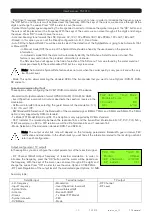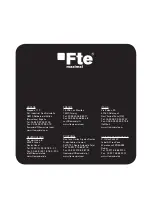
User’s manual · TSF 310
- 11 - TSF 310 version_en_1.1 FTE maximal
- Freq (Input Frequency (MHz)): Transponder frequency that you wish to tune. In order to introduce the frequency, press
the “OK” button and the cursor will be placed over the frequency. With the keys of the cursor, we can move through all the
digits and change the values. Press “OK” in order to save the value.
- Symbol Rate: Symbol speed required by the transponder. In order to introduce the symbol rate, press the “OK” button and
the cursor will be placed over the frequency. With the keys of the cursor, we can move through all the digits and change
the values. Press “OK” in order to save the value.
- Antenna: Feeding/tone towards the LNC. Options: 0V, 13V, 13V+22kHz, 18V, 18V+22KHz, 13V+AUT, 18V+AUT.
- DiseqC: In this option you can set the DiseqC configuration: A, B, C, D and None.
- Auto SR (Auto Symbol Rate): You will be able to select if the detection of the Symbol Rate is going to be Automatic (On)
or Manual (Off).
- In Manual mode (Off), the value of the Symbol Rate should be fixed by the user based on the provider’s
information.
- In Automatic mode (On), the meter will automatically identify the SR when a Satellite carrier is tuned. This
feature is very useful when the provider’s information is unknown.
The SR value found will appear in the field of selection of the SR menu. This value found by the meter could not
correspond exactly to the real broadcast SR, but to a very close value.
Note: The Automatic Symbol Rate feature does not work when the carrier quality is very poor or/and with a very
low Power Level.
- Mode: This option allows selecting the standard DVB of the transponder that you want to tune. Options: DVB-S1, DVB-
S2 and auto.
Terrestrial modulation (Out Terr)
These options allow configuring the DVB-T/DVB-H modulator of the device.
- Modulation: Output modulation format: QPSK (4 QAM), 16 QAM, 64 QAM.
- Invert (Spectrum inversion): Activate or deactivate the spectrum reverse in the
modulation.
- GI (Guard interval): Allows selecting the guard interval of the modulation: 1/4,
1/8, 1/16 and 1/32.
- BW (Bandwidth): Selection of the Bandwidth of the modulated signal: 8 MHz, 7 MHz and 6 MHz and 5MHz. The 5 MHz
option is only supported by DVB-H standard.
- Tx Mode (FFT Mode): 8K, 4K and 2k. The 4k option is only supported by DVB-H standard.
- FEC: Indicates the relationship between the redundant bits and the transmitted information bits:1/2, 2/3, 3/4, 5/6 y
7/8. For example, in a FEC = 2/3 relation we will find 2 information bits and 1 redundant bit.
- Mode: Selection of the modulation standard: DVB-T and DVB-H.
Note: The output useful bits rate will depend on the following parameters: Bandwidth, guard interval, FEC
codification and modulation. In the
Attachment I
you will find all the information related to the resulting useful bit
rate in each configuration.
Output configuration ( TV output)
In these options you can configure the output parameters of the terrestrial signal.
- RF Channel (MHz): Output frequency of terrestrial modulation. In order to
introduce the frequency, press the “OK” button and the cursor will be placed over
the frequency. With the keys of the cursor, we can move through all the digits and
change the values. Press “OK” in order to save the value. Options: 47-862 MHz.
- RF Level: Regulation of the output level of the modulated signal. Options: 0-15dB.
Summary table:
Satellite input
Terrestrial output
TV output
- L.O. frequency
- Input Frequency
- Symbol Rate
- Antenna
- Diseqc
- Symbol rate auto
- DVB Mode
- Modulation
- Invert (Spectrum Inversion)
- Guard Interval (GI)
- Bandwith (BW)
- Tx Mode (FFT Mode)
- FEC
- Mode
- RF Channel
- RF Level
TSF 310 *Out Terr
Modulation: 4
>Invert: No
GI: 1/32
TSF 310 *Out TV
Mode: DVB-H
>RF Channel: 474000
RF Level: 013
Summary of Contents for TSF 310
Page 1: ...TSF 310 USER S MANUAL...
Page 2: ......




















